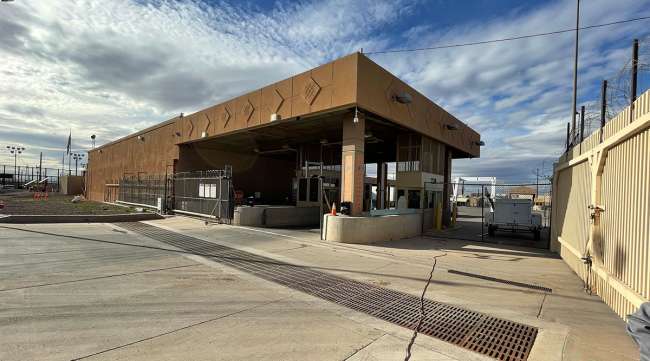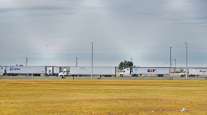Staff Reporter
New Arizona-Mexico Commercial Port Gets $275M Contract

[Stay on top of transportation news: Get TTNews in your inbox.]
The U.S. General Services Administration in October awarded a $275 million contract to create a large commercial border crossing in Arizona to facilitate bilateral trade with copper mines in Mexico.
The goal of the project is to improve the flow of truck traffic passing through the Douglas, Ariz., gateway to a major copper mining region in Mexico, GSA spokesperson Christi Chidester Votisek told Transport Topics. Construction of the new Douglas facility is scheduled to start next fall, with completion expected by the fall of 2028.
“Truckers can expect a state-of-the-art, all-electric facility with enclosed dock spaces designed for sustainability, efficiency and safety,” she added, noting the location will have photovoltaic solar panels, water-saving fixtures and energy-efficient building systems.
Greeley, Colo.-based Hensel Phelps Construction Co. was awarded the design-build contract for the port about 5 miles west of the Raul Hector Castro Land Port of Entry (RHC LPOE).
“By creating a new dedicated commercial land port of entry in Douglas and by relocating commercial operations there, GSA will be enhancing the capacity for oversized mining equipment that is too large to cross through the existing RHC LPOE along with the transport of essential supplies for the automotive, aerospace, farming equipment, electrical equipment, construction materials, refined copper wiring and medical industries,” Votisek said.

Votisek
Because improving the movement of commercial traffic there is critical, the federal government allocated $180.3 million in infrastructure funds and $92.2 million from the Inflation Reduction Act to the venture. The project also calls for modernizing and enlarging the existing RHC crossing for personal vehicles and pedestrians.
Now the RHC border crossing has a single commercial vehicle inspection lane that is congested and contributes to potential safety hazards given space limitations for inbound and outbound trucks. Both inbound and outbound trucks must maneuver within the same undersized commercial vehicle inspection compound.
In August, 2,495 commercial trucks traversed the border at the RHC crossing, according to the U.S. Department of Transportation’s Bureau of Transportation Statistics.
Once complete, U.S. Customs and Border Protection will move commercial operations from the Castro site to the new port.
The area of the existing Raul Hector Castro Land Port of Entry. (Google Maps)
“The new Douglas LPOE will feature four commercial inspection lanes, 30 enclosed and six open inspection docks, and a facility layout that streamlines inbound and outbound commercial truck traffic flow,” Votisek said. “The enclosed dock spaces will provide a regulated temperature for shipments identified for further inspection.
“Advanced technology will be integrated into the inspection process to facilitate faster and more thorough inspections, reducing wait times while enhancing security. It will also be equipped to process a wider variety of commercial goods.”
Also, the port will be able to handle oversize mining equipment that is unable to be processed now.
McLeod Software CEO Tom McLeod explores the potential for artificial intelligence to boost efficiency and build resilience. Tune in above or by going to RoadSigns.ttnews.com.
“The new Douglas Land Port of Entry will significantly increase our ability to inspect commercial vehicles and process goods more efficiently, all while supporting economic growth in the region,” CBP senior official Troy Miller said when the construction award was announced Oct. 3. “This project represents a critical investment in both the security of our nation and the prosperity of our border communities. By leveraging advanced technologies and sustainable design, we are also building a smarter, more resilient port of entry for the future.”
Votisek said GSA’s “investment will deliver a net-zero port facility and establish a new regional commercial hub and crossing point.”
“GSA is committed to designing, building, maintaining and operating world-class facilities that meet ambitious sustainability standards and mitigate climate change,” she said, “all while supporting CBP’s inspection and national security mission.”
Want more news? Listen to today's daily briefing below or go here for more info:





